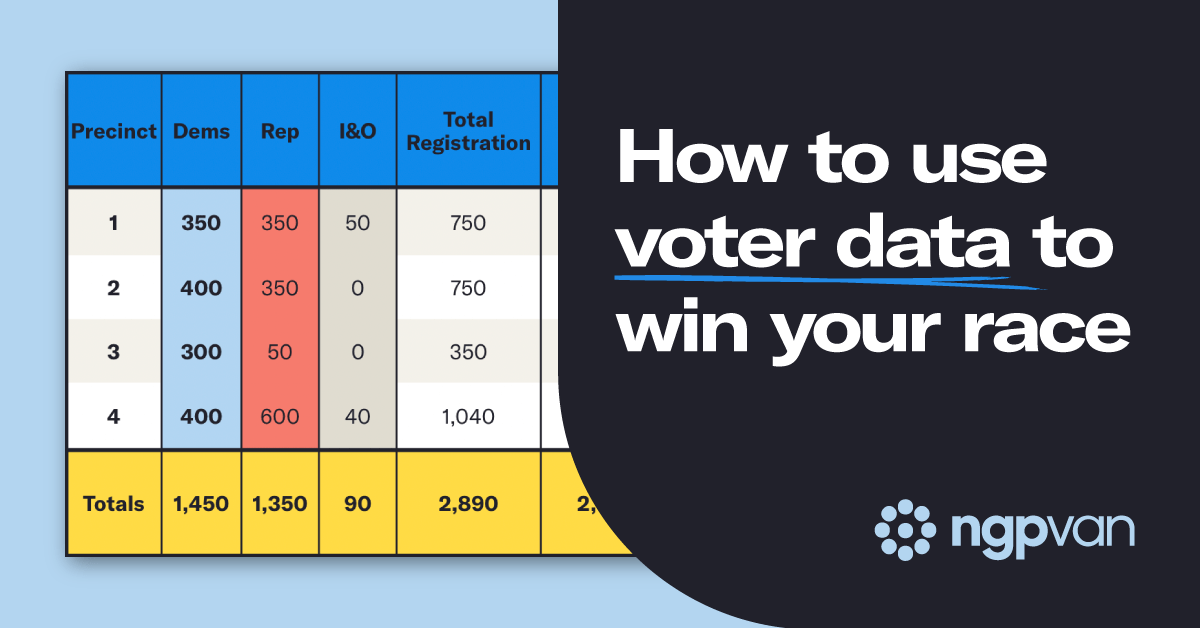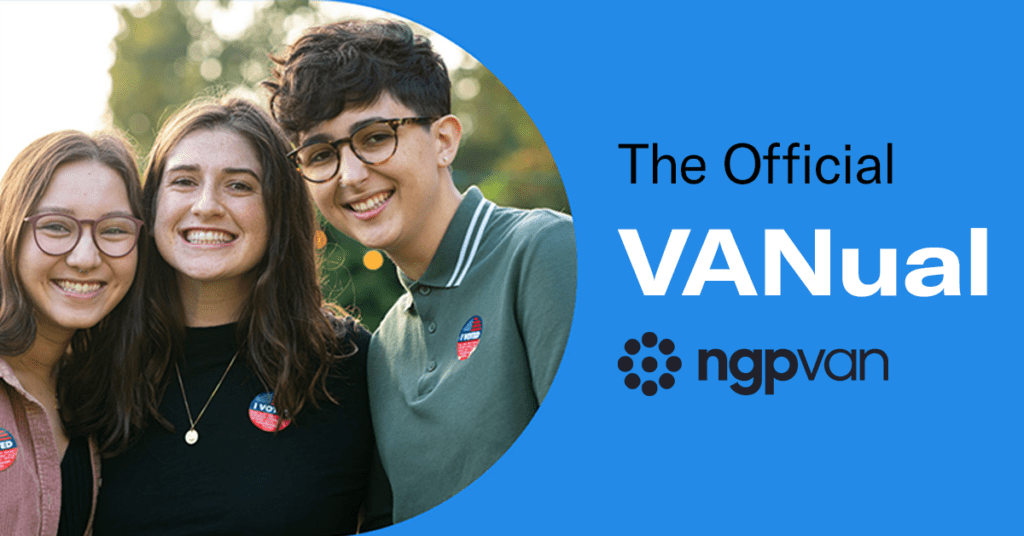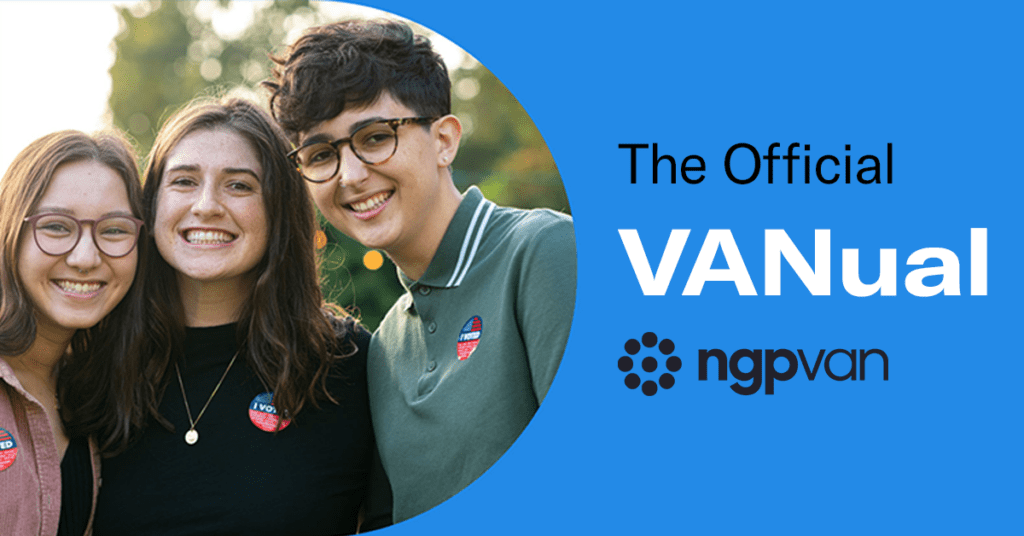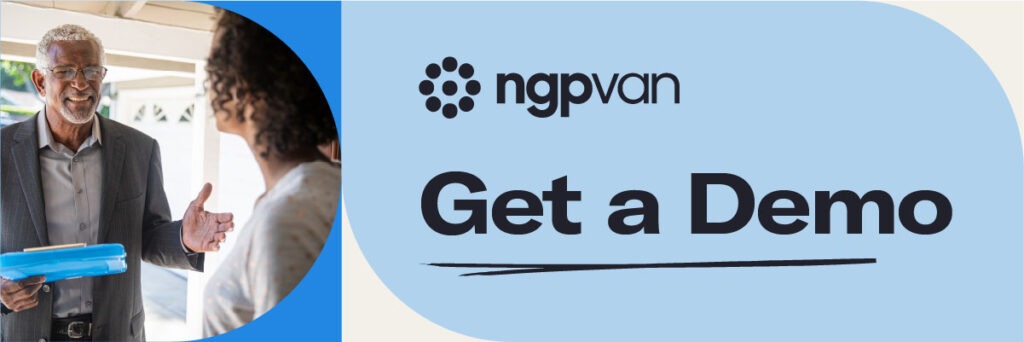How to use voter data to win your race

You’ve gained access to tons of voter data in VAN or SmartVAN, but how can you use it to win your race? In this blog, we explain why you need to use voter data, how to use it to create a targeted voter universe, what information you should collect during your outreach to that universe, and how you can use all that data to win your race.
Why you need to use voter data to win your race
If you want to run an efficient and effective campaign, you need to use voter data to set your campaign up for success. Creating a targeted voter universe based on voter data focuses your time and resources on the voters you need to win. It will be incredibly difficult to target your audience without using voter data, causing you to spend extra time and resources conducting outreach to voters who may not support your campaign.
In addition to using voter data to define your targeted voter universe, you also need a voter database to store other information you will gather during your outreach. NGP VAN’s voter file solutions, VAN and SmartVAN, allow you to easily record important voter information in a centralized database. Both solutions also help you parse through massive amounts of voter data to identify the voters you need to win, conduct targeted outreach to those voters while gathering more data, and then act on all that data to effectively and efficiently get out the vote to win your race. Now that you understand why you need to use voter data, let’s dive into how you can craft your targeted voter universe.
Create a targeted voter universe in the voter file
After you develop your win numbers for your primary and general election based on expected turnout, you will want to create a universe of voters that meets or exceeds those numbers. By building out your targeted voter universe in the voter file, you can focus your resources and outreach effectively to talk to the right voters at the right time.
Leading up to a primary election, you will want to talk to likely primary voters because you must win the primary election to advance to the general election. If your state requires voters to register with a political party, you can easily target registered Democrats in the voter file to begin building your voter universe. Crafting your universe can be a little more complicated if your state does not require voters to register with a political party. It’s typically best to try and target voters based on either past primary voting history or propensity (support) scores, which can help you evaluate who is likely to turn out for Democrats in the upcoming primary election.
You can easily create a list of likely primary voters in the voter file and save it as a Saved List (a fixed list of people) or Saved Search (a search that updates when voter profile information changes). After saving the list, you can then further segment this universe and start conducting outreach to win your primary election. If you don’t have a contested primary election, you will still want to reach out to this voter universe to secure your support early.

After the primary election passes and you advance to the general election, you will want to work towards achieving your general election win number. If you were in a contested primary, you will want to consolidate your support among primary voters who will hopefully support you heading into the general election. There may also be people who voted in your primary election that you did not contact in your initial outreach. It’s a good idea to contact these voters after the primary to try and gain more support and volunteers for your campaign heading into the general election.
Again, you will want to create this universe based on your general election win number. You’ll want to conduct a precinct-level analysis to learn where you will find the votes you need to win based on past election results and data in VAN. We describe how to conduct a precinct-level analysis in our How to Win Your Local Election Guide, but the summarized version is that you want to figure out where you need to boost turnout, flip voters, and minimize losses to match or exceed your win number to define your voter outreach strategy.
Define your voter outreach strategy
If your district leans heavily towards Democrats, you may want to consider focusing more on turning out your base supporters to win. You can easily target these likely or registered Democratic voters in VAN to focus your advertising and outreach efforts on those voters to get them out to vote. If they’re likely Democratic voters, you don’t have to spend as much time convincing them to vote for you, you just need to make sure they get out and vote on or before Election Day.
If your district is a toss-up or leans towards Republicans, you may need to build a persuasion audience to hit your win number. A persuasion audience is just what it sounds like – a group of people who need to be persuaded to vote for you. It may be composed of people who only vote in general elections, independents, registered voters of another political party, or people who haven’t voted recently. Outreach to these individuals typically takes more time and resources, but convincing these voters to vote for you can help you win your race, especially if you’re in a competitive district. Also, consider that even if you convince some of these voters to not vote for your opponent, that’s also valuable, as it’s one less vote you need to make up elsewhere.
While conducting voter outreach, you want to collect as much voter data as possible. By collecting this data during your initial outreach, you can further make your conversations more relevant to voters in the future and identify supporters to make sure they get out to vote on or before Election Day.
Collect voter data to record important information and identify supporters
When you’re developing your script for voter outreach, you typically build it around survey questions like “What issues are important to you?” or “Can I count on your vote?” By asking voters what issues are important to them, you can more directly speak to the voter and their concerns and what you’d like to do to address those issues if you are elected. In addition to addressing those issues with that voter, you’re also gathering more information to analyze soon. As you work through your voter universe, you may better understand what issues are important to most voters in the district so you can adjust your messaging if needed.
The other important question you will want to ask gauges support for your campaign (sometimes known as a supporter ID question). The question is usually something like “Can I count on your vote?” or “Will you vote for *insert candidate’s name* in the upcoming election?” Responses to this question are typically ranked on a scale from 1 to 5 that indicate different levels of support, with a “1” signifying strong support for your campaign and a “5” signifying strong opposition to your campaign. Most of the time, you’ll be able to gauge support based on your conversation with the voter, but it’s important to ask the question to confirm their support. If they plan to support your campaign, you should also ask them if they’d be willing to volunteer for your campaign or if you could put a sign in their yard. You can easily track this information by creating Activist Codes in VAN and adding them to your scripts.

As you continue reaching out to voters through various contact methods, you continue to build your database and relevant data points to act on leading up to GOTV (get out the vote), the time when you focus on turning out your supporters to vote as soon as possible and convince undecided voters If you have the time and resources available, you can also try to sway some of your opponent’s supporters, but it’s often a difficult and time-consuming process to complete. Evaluate the number of likely and identified supporters to strategically dedicate your resources and time heading into Election Day.
Use voter data to get out the vote and win
GOTV starts whenever voters can cast their ballots. In some states, voters can vote by mail or early over a month before Election Day, so make sure you know when to start getting out the vote for your campaign! As you progress through GOTV, you will want to implement a ballot chase program to score early votes for your campaign and contact voters to ensure they have all the information they need to vote on or before Election Day.
Implement a ballot chase program
Many states allow voters to vote by mail (sometimes known as absentee voting), which lets voters cast their ballots well before Election Day. VAN makes it easy to find voters who are voting by mail, identify where they are in the voting process, and remove them from lists after they vote. While you’re creating a list in VAN, you can click under the Early Voting tab and easily target voters who have requested or been mailed a ballot from your targeted voter universe. You may also want to search for likely supporters whom you haven’t contacted yet who have requested ballots to gauge their support for your campaign.
If you have identified supporters who haven’t requested a ballot yet, encourage them to request one if they’re eligible and return it as soon as possible! You also want to make sure to contact both identified and likely supporters who have outstanding ballots to ensure that no votes are left on the table (figuratively and literally).
We outline what a ballot chase program is and how to implement one and other methods to score votes early in this blog, but simply put, a ballot chase program will allow you to bank votes early for your campaign and make your voter outreach more efficient heading into Election Day.
Heading into Election Day
In the weeks leading up to Election Day, you will want to contact your supporters to make sure they have all the information they need to vote on or before Election Day. Thankfully, because you’ve been collecting supporter IDs, you’ll be able to create a list of voters with favorable support scores and focus on getting them out to vote.
You can also pull a list of undecided voters and contact them again to see if you can finally sway them to support your campaign. It’s best if you or a trusted volunteer contact these voters specifically to try and convince them to vote for your campaign.
During GOTV conversations, you want to plan with your supporters how, when, and where they’re going to vote for your campaign. Ideally, you want your supporters to vote early, so you can remove them from your contact lists and focus resources on voters who haven’t voted yet. If you create another Survey Question in VAN, you can also track responses for how voters plan to vote (by mail, early, or on Election Day), which can be helpful information to gather to inform future outreach.
Once voters have cast their ballots, VAN makes it easy to remove them from your contact lists. When you’re creating a list, there is a check box to remove voters who have already voted. If you’re setting up a Virtual Phone Bank or an Open Virtual Phone Bank, you can exclude people who have Early Voted or Absentee Voted. By checking these boxes, you’ll be directing your contact efforts toward voters who haven’t voted yet. This functionality is incredibly helpful as you continue to contact voters all day on Election Day until they get out and vote.
Using the voter file and voter data to win your race
Both of our voter file solutions, VAN and SmartVAN, make it possible to use voter data to identify the targeted universe you need to win, reach out to and record information about those voters, and then use that data to effectively and efficiently get out the vote to win your race. By following the steps in this blog, you can set your campaign up for success on Election Day.
Get a demo of our voter file solutions.

Additional Resources
Interested in learning more about how NGP VAN software can support your campaign? Here are a few additional resources that help you build your email lists, engage supporters and donors, and win your race!
- How to Win Your Local Election Guide. Our all-inclusive campaign guide to learn what it takes to run for political office and win.
- Political Canvassing: 6 Tips for Your Volunteers. Check out these six tips before you start knocking doors and talking to voters!
- How to Run a Ballot Chase Program and Score Votes Early. Learn what a ballot chase program is and how VAN can help you easily implement one to bank early votes for your campaign.



